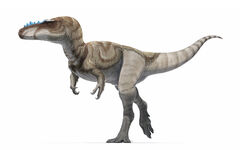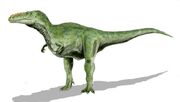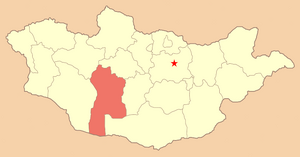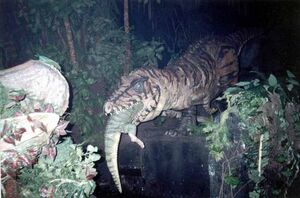| Alioramus | |
|---|---|

| |
| An artist's interpretation of Alioramus | |
| Scientific classification | |
| Kingdom: | Animalia |
| Phylum: | Chordata |
| Class: | Sauropsida |
| clade: | Dinosauria |
| Superorder: | Theropoda |
| Superfamily: | †Tyrannosauroidea |
| Family: | †Tyrannosauridae |
| Subfamily: | †Tyrannosaurinae |
| Tribe: | †Alioramini |
| Genus: | †Alioramus Kurzanov, 1976 |
| Type species | |
| †Alioramus remotus Kurzanov, 1976 | |
| Referred species | |
| |
| Synonyms | |
| |
Alioramus (/ˌælioʊˈreɪməs/; meaning 'different branch') is a genus of tyrannosaurid theropod dinosaurs from the Late Cretaceous period of Asia. The type species, A. remotus, is known from a partial skull and three foot bones recovered from Mongolian sediments which were deposited in a humid floodplain about 70 million years ago. These remains were named and described by Soviet paleontologist Sergei Kurzanov in 1976. A second species, A. altai, known from a much more complete skeleton, was named and described by Stephen L. Brusatte and colleagues in 2009. Its relationships to other tyrannosaurid genera are unclear, with some evidence supporting a hypothesis that Alioramus is closely related to the contemporary species Tarbosaurus bataar.
Characteristics

Size of A. remotus compared with a human
| Alioramus were bipedal like all known theropods, and their sharp teeth indicate that they were carnivores. Known specimens were smaller than other tyrannosaurids like Tarbosaurus bataar and Tyrannosaurus rex, but their adult size is difficult to estimate since both species are known only from juvenile or sub-adult remains. The recent discovery of Qianzhousaurus indicates that it belongs to a distinct branch of tyrannosaur.[2] The genus Alioramus is characterized by a row of five bony crests along the top of the snout, a greater number of teeth than any other genus of tyrannosaurid, and a lower skull than other tyrannosaurids. |
Alioramus remotus
Alioramus remotus was estimated at 5 to 6 metres (16 to 20 ft) in length when originally described by Sergei Kurzanov in 1976.[3] Kurzanov, however, did not correct for lengthening of the skull by deformation during fossilization, which may indicate a shorter overall body length for this individual. If this specimen is a juvenile, then adult Alioramus would have reached greater lengths, but no confirmed adult specimens are known.[4]
The skull of A. remotus was approximately 45 centimetres (18 in) long.[5] In general, it is long and low, a shape typical of more basal tyrannosauroids and juveniles of larger tyrannosaurids. The premaxillary bones at the tip of the snout in Alioramus remotus have not been found, but are taller than wide in all tyrannosauroids for which they are known.[4] The nasal bones are fused and ornamented with a row of five irregular bony crests that protrude upwards from the midline, where the nasal bones are sutured together. These crests all measure more than 1 centimetre (0.39 in) tall.[3]

Artist's impression of A. remotus
At the back of the skull there is a protrusion, called the nuchal crest, arising from the fused parietal bones, a feature shared with all tyrannosaurids. In Alioramus, the nuchal crest is greatly thickened, similarly to Tarbosaurus and Tyrannosaurus. Like the rest of the skull, the lower jaw of Alioramus was long and slender, another possible juvenile characteristic.[4] As in Tarbosaurus, a ridge on the outer surface of the angular bone of the lower jaw articulated with the rear of the dentary bone, locking the two bones together and removing much of the flexibility seen in other tyrannosaurids.[6] Other tyrannosaurids had four premaxillary teeth, D-shaped in cross section, on each side. Including 16 or 17 in each maxilla, and 18 in each dentary, Alioramus had 76 or 78 teeth, more than any other tyrannosaurid.[7] The braincase of A. altai was intermediate between the basal theropod and avialan conditions.[8]
The rest of the skeleton of Alioramus remotus is completely unknown except for three metatarsals (bones of the upper foot), but the discovery of A. altai, which is known from substantially more complete remains, has shed light on the anatomy of the genus.[9]
Alioramus altai
Paleontologists have long classified Alioramus within the superfamily Tyrannosauroidea, but because its remains were for many years poorly known, a more precise classification had remained elusive until the discovery of A. altai.[4] A cladistic analysis published in 2003 found Alioramus could be further classified into the family Tyrannosauridae and the subfamily Tyrannosaurinae, alongside Tyrannosaurus, Tarbosaurus and Daspletosaurus.[10] A 2004 study supported this result but suggested it was equally probable that Alioramus belonged outside the family Tyrannosauridae entirely, with its supposed juvenile characters actually reflecting a more basal position within Tyrannosauroidea.[4] Another study omitted Alioramus altogether due to the only specimen's fragmentary nature.[11] The discovery of A. altai in 2009 confirmed the placement of the genus within the Tyrannosaurinae.[9]
Tarbosaurus and Alioramus shared several skull features, including a locking mechanism in the lower jaw between the dentary and angular bones, and both lacked the prong of the nasal bones which connected to the lacrimal bones in all other tyrannosaurids except adult Daspletosaurus. The two genera may be closely related, representing an Asian branch of the Tyrannosauridae.[6][10] Some specimens of Tarbosaurus have a row of bumps on the nasal bones like those of Alioramus, although much lower. The long and low shape of the only known Alioramus remotus skull indicated that it was immature when it died and might even have been a juvenile Tarbosaurus, which lived in the same time and place. The more prominent nasal crests and much higher tooth count of Alioramus, however, suggested it was a separate taxon, even if it is known only from juvenile remains,[7] confirmed by the discovery of A. altai.[9] Specimens identified as immature Tarbosaurus have the same tooth count as adults.[12][13]
Cladogram
Recently a cladogram has been published finding Alioramus just outside Tyrannosauridae. Below is the cladogram by Loewen (2013).[14]
| |||||||||||||||||||||||||||||||||||||||||||||||||||||||||||||
However, a few later studies have found Alioramus to lie inside Tyrannosaurinae with Qianzhousaurus in a separate tribe, Alioramini.
The phylogeny below is from the analysis by Stephen L. Brusatte & Thomas D. Carr (2016).
| Tyrannosauridae |
| ||||||||||||||||||||||||||||||||||||||||||||||||||||||||||||||||||||||||
Discovery and naming
The holotype (PIN 3141/1) of Alioramus is a partial skull associated with three metatarsals. A joint Soviet-Mongolian expedition to the Gobi Desert in the early 1970s found these remains at a locality known as Nogon-Tsav in the Mongolian province of Bayankhongor. Alioramus was named and described by Russian paleontologist Sergei Kurzanov in 1976. Its crests and low skull profile looked so different from other tyrannosaurids that Kurzanov believed his find was far removed from other members of the family. Accordingly, he gave it the generic name Alioramus, derived from the Latin alius ('other') and ramus ('branch'), and the specific name A. remotus, which means 'removed' in Latin.[3] Alioramus is known from the holotypes of A. remotus[4] and A. altai.[9]
Prehistoric Asia

Bayankhongor, the Mongolian aimag (province) where Alioramus remains were discovered.
The Template:Wp stage in Template:Hw (72.1 to 66 million years ago), as preserved in the Template:Wp and at Template:Wp, was characterized by a wetter and more humid climate compared with the semi-arid environment preserved in the earlier, underlying Barun Goyot and Template:Wps. The Beds of Nogon-Tsav are considered to be the same age as the Template:Wp.[3] This Template:Wp has never been dated radiometrically, but the Template:Wp present in the fossil record indicate it was probably deposited at the end of the Late Cretaceous in Maastrichtian.[15]
Nemegt sediments preserve Template:Wps, large river channels and soil deposits, but caliche deposits indicate periodic droughts.[16] This environment supported a more diverse and generally larger dinosaur fauna than in earlier times. Kurzanov reported that other theropods, including Template:Dp, Template:Dps and Template:Dps were discovered at the same locality,[3] but these remains have never been reported in detail. If the Nogon Tsav fauna was similar to that of the Nemegt Formation, Template:Dp theropods, as well as Template:Dps, Template:Dps and Template:Dps would also have been present.[15] Template:Dpn Template:Dps were also potential prey for predators in the Nemegt..[6]
A recent paper describing a new species of Daspletosaurus, D. horneri, has suggested that Qianzhousaurus is the same genus as Alioramus, just a different species.[1]. If this is the case, then Alioramus was also present in Southern China.
In popular culture
In the enhanced-motion vehicle attraction Dinosaur at Disney's Animal Kingdom theme park, an Alioramus is announced by an on-board computer, and is seen digging in the ground. As the vehicle nears the rooting dinosaur, it raises up to reveal a smaller animal in its mouth, which it proceeds to swallow as the prey kicks it hind legs and lashes with its tail, to no avail. Both creatures are brought to life through Audio-Animatronics.
See also
- Timeline of tyrannosaur research
References
- ↑ 1.0 1.1 (2017) "A new tyrannosaur with evidence for anagenesis and crocodile-like facial sensory system". Scientific Reports 7: 44942. DOI:10.1038/srep44942.
- ↑ Junchang Lü (7 May 2014). "A new clade of Asian Late Cretaceous long-snouted tyrannosaurids". Nature Communications 5 (3788). DOI:10.1038/ncomms4788.
- ↑ 3.0 3.1 3.2 3.3 3.4 Kurzanov, Sergei M.. "A new carnosaur from the Late Cretaceous of Nogon-Tsav, Mongolia" (in Russian). The Joint Soviet-Mongolian Paleontological Expedition Transactions 3: 93–104.
- ↑ 4.0 4.1 4.2 4.3 4.4 4.5 Holtz, Thomas R. (2004). "Tyrannosauroidea". In Weishampel, David B.; Dodson, Peter; & Osmólska, Halszka (eds.). The Dinosauria (Second ed.). Berkeley: University of California Press. pp. 111–136. ISBN 0-520-24209-2.
- ↑ Currie, Philip J. (2000). "Theropods from the Cretaceous of Mongolia". The Age of Dinosaurs in Russia and Mongolia. Cambridge: Cambridge University Press. pp. 434–455. ISBN 978-0-521-54582-2.
- ↑ 6.0 6.1 6.2 Hurum, Jørn H. (2003). "Giant theropod dinosaurs from Asia and North America: Skulls of Tarbosaurus bataar and Tyrannosaurus rex compared". Acta Palaeontologica Polonica 48 (2): 161–190.
- ↑ 7.0 7.1 Currie, Philip J. (2003). "Cranial anatomy of tyrannosaurids from the Late Cretaceous of Alberta". Acta Palaeontologica Polonica 48 (2): 191–226.
- ↑ "Variation, Variability, and the Origin of the Avian Endocranium: Insights from the Anatomy of Alioramus altai (Theropoda: Tyrannosauroidea)". PLOS Collections. http://www.ploscollections.org/article/info%3Adoi%2F10.1371%2Fjournal.pone.0023393;jsessionid=B5ED8399160D7F46A7647ADE513F5B9C.ambra01. Retrieved 2012-11-09.
- ↑ 9.0 9.1 9.2 9.3 Brusatte, Stephen L. (2009). "A long-snouted, multihorned tyrannosaurid from the Late Cretaceous of Mongolia". Proceedings of the National Academy of Sciences of the United States of America online preprint (41): 17261–6. DOI:10.1073/pnas.0906911106. PMID 19805035.
- ↑ 10.0 10.1 Currie, Philip J. (2003). "Skull structure and evolution in tyrannosaurid phylogeny". Acta Palaeontologica Polonica 48 (2): 227–234.
- ↑ Carr, Thomas D. (2005). "A new genus and species of tyrannosauroid from the Late Cretaceous (middle Campanian) Demopolis Formation of Alabama". Journal of Vertebrate Paleontology 25 (1): 119–143. DOI:[0119:ANGASO2.0.CO;2 10.1671/0272-4634(2005)025[0119:ANGASO]2.0.CO;2].
- ↑ Maleev, Evgeny A. (1955). "New carnivorous dinosaurs from the Upper Cretaceous of Mongolia" (in Russian). Doklady Akademii Nauk SSSR 104 (5): 779–783.
- ↑ Currie, Philip J. (2003). "Allometric growth in tyrannosaurids (Dinosauria: Theropoda) from the Upper Cretaceous of North America and Asia". Canadian Journal of Earth Sciences 40 (4): 651–665. DOI:10.1139/e02-083.
- ↑ (2013) "Tyrant Dinosaur Evolution Tracks the Rise and Fall of Late Cretaceous Oceans". PLoS ONE 8 (11): e79420. DOI:10.1371/journal.pone.0079420.
- ↑ 15.0 15.1 Jerzykiewicz, Tomasz (1991). "Late Mesozoic stratigraphy and vertebrates of the Gobi Basin". Cretaceous Research 12 (4): 345–377. DOI:10.1016/0195-6671(91)90015-5.
- ↑ Osmólska, Halszka (1997). "Nemegt Formation". In Currie, Philip J.. The Encyclopedia of Dinosaurs. San Diego: Academic Press. pp. 471–472. ISBN 0-12-226810-5.
External links
- Alioramus remotus at DinoData.org
- Alioramus remotus at The Theropod Database
- Skull image of Alioramus at The Grave Yard
- Illustration showing the pieces found of Alioramus altai.









